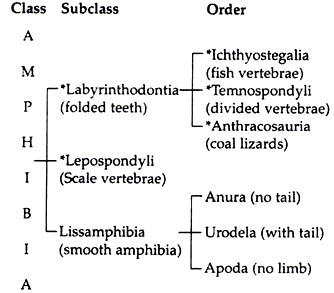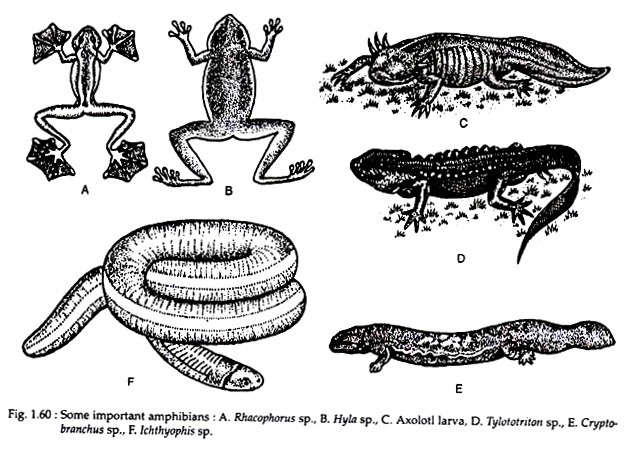In this article we will discuss about:- 1. Habit and Habitat of Amphibians 2. Origin of Amphibians 3. General Characters 4. Classification Scheme.
Habit and Habitat of Amphibians:
Amphibians are cold blooded vertebrates having a smooth or rough, naked skin, rich in glands, which keep it moist, if scales are present, it is hidden in the skin. They are quite numerous and successful in the ecological niches that they occupy and make an important element in many food-chains. There are nearly 2,000 species identified so far, and placed in 250 genera.
Although amphibians are well adapted for certain situations, it is remarkable that they do not succeed in maintaining themselves in many different types of habitat. There are desert toads, e.g., Chiroleptes of Australia, but these survive by burrowing and by special abilities, such as the power to hold large amounts of water, associated with loss of the glomeruli of the kidneys.
The fossils of amphibian ancestors and early amphibians have been discovered in sediments of the middle and late Devonian period in Greenland and Australia. Therefore, it is assumed that the first amphibians originated during Devonian period. The classifications of amphibians are made by various authors in different ways.
Origin of Amphibians:
ADVERTISEMENTS:
During the later part of the Devonian period a population of osteolepid fishes started crawling from pool to pool and spending more time on the land. They gave rise to a terrestrial population that we distinguish as Amphibia. This is the common idea of amphibian origin. But some herpetologists argued in different ways — these are as follows.
1. Polyphyletic view of amphibian origin:
Carroll and Currie (1975), Jarvik (1980) hypothesized that the three living orders, e.g., Anura, Urodela and Apoda have evolved separately. Jarvik also pointed out that the amphibians originated independently from more than one group of rhipidistian fishes. But this view is readily rejected by all scientists.
2. Di-phyletic view of amphibian origin:
ADVERTISEMENTS:
Romer (1945), Romer and Watson (1962) opined that both salamanders and caecilians share a common ancestor and anurans were developed separately. By emphasizing on the vertebral column similarities in the different groups, it is considered that anurans have evolved from labyrinthodonts and urodeles and apodans from lepospondyls.
3. Monophyletic view of amphibian origin:
According to this view all living amphibians have evolved from the earliest amphibians the Ichthyostega and this group is also derived from Osteolepid fish. The proponents of this view are Noble (1931), Bolt (1979), McFarland (1985), Duellman and Trueb (1986).
General Characters of class Amphibians:
1. The body of amphibians comprises of a distinct head with elongated trunk. Neck and tail may be present or absent.
ADVERTISEMENTS:
2. Highly glandular, moist skin is naked. In some apodans, dermal scales are present.
3. The body of amphibians is provided with two pairs of pentadactylous limbs.
4. Forelimbs are with four and hind limbs are with five clawless digits.
5. The body is ectothermic (poikilothermous or cold blooded or adjusters).
6. Eyes are often with eyelids. A tympanum is present.
7. Gut ends into a cloaca.
8. Three chambered heart. R.B.C. nucleated.
9. In adults respiration is performed by lungs, skin and buccopharyngeal cavity.
10. In adult salamanders, kidney is mesonephric type, while in caecillans it is opisthonephric type.
ADVERTISEMENTS:
11. Central nervous system possess ten pairs of cranial nerves.
12. Procoelous vertebrae lacks ribs.
13. The skull possesses two occipital condyles. Post temporal fossa and ectopterygoid are absent.
14. Eggs are large, yolky and mesolecithal type.
15. Generally an aquatic tadpole larval stage is present in the life history.
Classification Scheme of Amphibians:
Class — Lissamphibia (Gk. Lissos = smooth):
General characters:
1. Members of this class are found throughout the tropical and temperate parts of the world.
2. They possess a broad skull, the orbits enlarged into cheek and temporal regions.
3. Teeth are fang-like, i.e., pedicellate.
4. Vertebrae are monospondylics (i.e., wanting separate intercentra).
5. In the ear, auricular operculum and columella are present.
6. Scale-less smooth skin possess numerous glands.
7. Respiration through skin.
Class — Anura (Sometimes referred to as Salientia) (Gk. an = without; oura = tail):
General characters:
1. These animals are short, four-legged, stout bodied and tailless organisms.
2. They possess well developed eyelids and distinct tympanum.
3. Large eyes are situated well ahead of the head, giving binocular vision.
4. Wide mouth, may or may not possesses tongue.
5. The posterior limbs are longer than the anterior limbs.
6. Frontal and parietal bones of the skull are joined to form a single bone called frontoparietal.
7. Mandible is devoid of teeth.
8. There are five to nine pre-sacral vertebrae in the vertebral column.
9. The post-sacral vertebrae are fused to form a rod-like structure, called urostyle.
10. Vertebrae always possess zygapophyses and transverse processes except the atlas.
11. The tibia and fibula (= astragalus and calcaneum) are fused at least proximally and distally.
12. Generally fertilisation is external. Tadpole larva metamorphoses to adult.
Examples:
Duttafrinus melanostictus (common Indian toad), Ansonia (South India), Bufoides (Meghalaya), Pedostibes (South India), Hyla annectans (Only Indian Hyla, found in Meghalaya and Assam) (Fig. 1.60B), Rana tigerina (Indian Bull frog), Rhacophorus malabaricus (Kerala and Karnataka) (Fig. 1.60A).
Order — Urodela (also known as Caudata) (Gk. Oura = tail; delos = visible):
General characters:
1. These animals are lizard-like in appearance, with distinct head and a well- developed tail.
2. There are two pairs of weak limbs in the body.
3. In aquatic forms a lateral line system is present.
4. Small eyes are without lids. In cave- dwellers, eyes are lost.
5. Intestine forms several loops.
6. Usually four pairs of aortic arches are present.
7. The columella in the middle ear is absent.
8. Kidney is opisthonephric type.
9. In the skull, cartilagenous elements are only found in occipital region.
10. The vomer and palatine are fused to form vomero-palatine.
11. Vertebrae may be amphicoelous or opisthocoelous, with ribs.
12. Simple pectoral girdle is composed of cartilage.
13. There is an Y-shaped bone epipubis attached to the pubis.
14. Fertilisation is generally internal.
15. Paedomorphosis or paedogenesis is prevalent in some families, which are recognised by the retention of larval characteristics including lateral line system, true teeth on both jaws, gill slits and external gill, e.g. Axolotl larva (Fig. 1.60C).
Examples:
Tylototriton (Only Indian Genus) (Fig. 1.60D), Ambystoma, Triton, Necturus, Proteus, Siren, Amphiuma, Salamandra, Triturus, Cryptobranchus (Fig. 1.60E).
Order — Apoda (Also known as Gymnophiona or Caecilia):
General characters:
1. These are worm-like, limbless burrowing creatures.
2. Body smooth, slimy and externally segmented by a series of annular grooves within which small, granular dermal scales are embedded.
3. Lidless eyes are reduced and covered by the skin or by the maxillary bones.
4. A peculiar conical flap-like, protrusible sensory tentacle in between nostril and eye is present.
5. Both the tympanum and tympanic cavity are absent.
6. Tongue is fused with the floor of the mouth cavity.
7. Tail, if present, is short and conical.
8. Skull is solid and compact. Maxilla and palatine fused to form maxillopalatine.
9. Teeth are present on the premaxilla, maxillopalatine, vomer and dentaries.
10. Vertebrae are amphicoelous and with persistent notochord.
11. Pectoral and pelvic girdles are absent. There is no sternum.
12. Intestine is straight.
13. Lungs are asymmetrical — only right lung is well developed.
14. Only pulmonary and systemic arches are present. Carotid arises from systemic.
15. Fertilisation may be external or internal.
16. The eggs are large and yolky.
Examples:
Ichthyophis (India) (Fig. 1.60F), Uraeotyphlus malabaricus (South India), Gegenophis (South India), Indotyphlus (Maharashtra).

